Just a couple weeks ago, I talked about how much I had been enjoying the Wotakoi manga, and how I yearned for more josei manga that centered around the relatable struggles of women’s everyday lives. I had forgotten that the print edition of Akiko Higashimura’s Tokyo Tarareba Girls would be coming out so soon, and it is another shining example of exactly what I’ve been looking for.
I want to preface the meat of my review by saying that I am very different from the story’s protagonist, Rinko. I am 28 years old, happily married, and while I’m still trying to figure out my career, I am at least heading in a direction that feels fruitful. And even if all that weren’t the case, I very strongly do not ascribe to societal ideas about appropriate ages to marry, have children, etc. But a lot of women do, and that external pressure can be suffocating.
Rinko, at 33, is an established screenwriter for various webseries dramas. She is not only unmarried, but has also not really been dating for quite some time. Our story starts with her 33rd birthday and the announcement that Tokyo will be hosting the 2020 Olympics. Suddenly, she feels that she doesn’t want to remain unwed once the Olympics start, so she’s given herself a deadline to find a husband.
The only problem is, she’s not working particularly hard to meet anyone new! She hopes that a man she works with who had shown interest in her ten years previously might be interested again, but he has moved on to her much younger, pink-haired coworker, leaving Rinko feeling old and unwanted. At the pub she and her friends frequent, they encounter a rude young man who tells them plainly that they’re wasting time getting drunk, and that their activities are less like a “girls’ night,” and more like an “old maids’ gossip circle.” He is the one who first calls them “”what-if” women, and while he’s extraordinarily rude, something about his words rings true for Rinko. When he shows up to audition for one of her dramas and complains about the script, she loses her position on that series and begins to truly feel that she is unwanted.

And this, for me, is what Tokyo Tarereba Girls is about: the fear of being unwanted once you are no longer young, pretty, and willing to please. There is an insidious idea that women are no longer interesting once they become — pardon my language — unfuckable. In fact, Rinko loses her position to a younger woman who she discovers is sleeping with the producer, causing Rinko to spiral into a deep depression. At the close of the first volume, the rude young model/actor, Key, offers her a way to get ahead.
Tokyo Tarereba Girls has been available in English digitally through Kodansha for some time now, so I’ve seen a fair amount of single panels or discussions of its message and meaning (without completely spoiling myself, of course). It is my feeling that the story will go on to redefine Rinko’s position that she needs to be married to one where she learns to focus on herself and her goals, without buckling to outside pressure. At least, that’s what I hope!

In many ways, Tokyo Tarereba Girls isn’t a happy story. So many women (and I’m sure folks of other genders, as well) feel adrift in a sea of societal expectation. There are so many thinkpieces out there on millennials “choosing” not to buy houses or have children; even if you have no interest in bending to the whims of society, it’s hard to avoid acknowledging that you don’t tick off certain boxes. And yet, Higashimura delivers this anxiety wrapped in the sense of humor that set Princess Jellyfish apart before; there is no attempt to show Rinko and her friends as beautiful paragons of virtue who are underserving of their fate. They are all normal women, with normal lives and normal stresses. They are crass and selfish, women who we might not want to be, but who we recognize in ourselves and in our friends and family.
It is tempting to claim that women like Rinko, who obsess over age, desirability, and the perceived expectations of others, are silly and shallow. Indeed, it is not uncommon to see this kind of criticism even coming from other women. So it was rather refreshing to see, at the back of this first volume, Higashimura’s own beliefs about marriage — essentially, that she fell into it by accident and that she doesn’t put too much weight on its merits. She has pushed back against her friends for their own fears, encouraging them to eschew their anxieties and just live their lives…but then she has also crafted this story highlighting those very real anxieties. She cannot relate to her friends in real life, but she can understand the concerns they have enough to show readers their value.
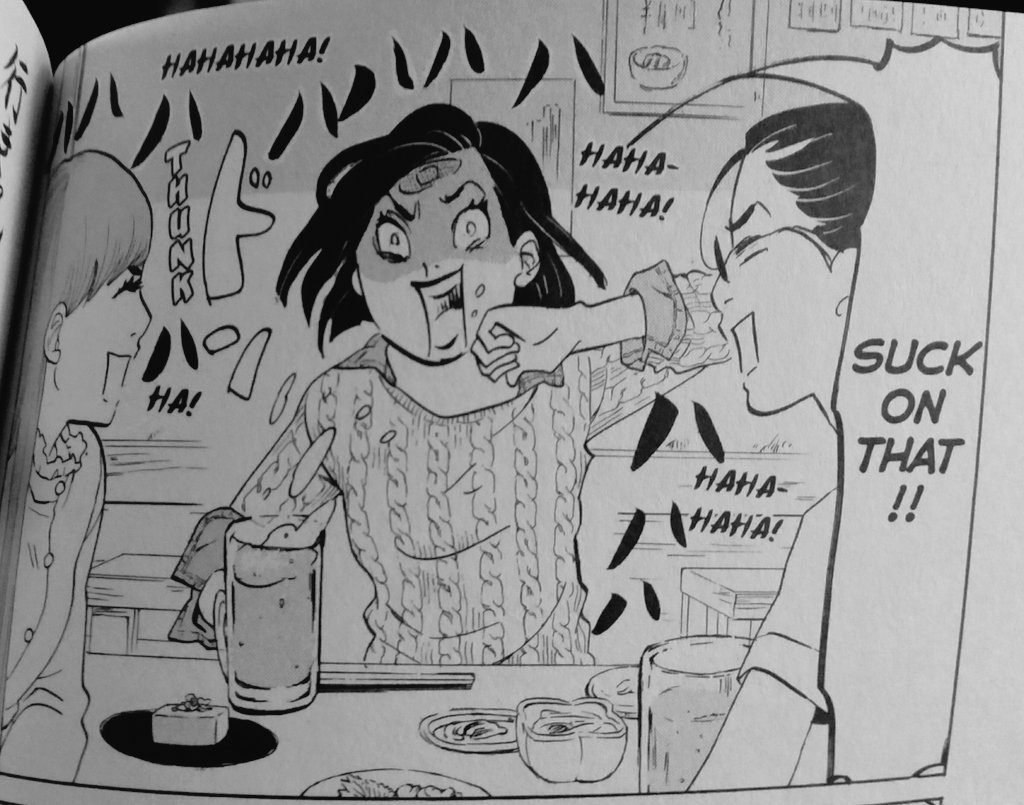
Since manga began legal English-language circulation, there have always been stories centered around adult men and their struggles and fantasies. It is gratifying to know that the girls and women who facilitated the huge manga boom of the late 90s and early aughts now have manga that have grown up with them, with protagonists their age who also may feel adrift, alone, and unwanted as they age and change. I believe that the manga market is ready for more josei and has been for a while now.
Because I’m terrible at keeping up with digital releases, I’m looking very forward to continuing Tokyo Tarareba Girls as it comes out in print. I know that she’s been acknowledged extensively in Japan, but I really hope to see Akiko Higashimura recognized for her genius in the North American market. To that end, I encourage everyone to try her work, whether it be this or Princess Jellyfish. She captures the struggle of being a woman from so many different perspectives and with such sensitivity, without sacrificing either wit or drama. She truly is a spectacular creator.
Anime On the Big Screen
I have mentioned in the past that I am astounded by how available anime is now, compared to when I was a young teen and becoming really invested in it as a medium. One of the more shocking aspects of that availability is seeing anime films in movie theatres.
Last Wednesday, I had the distinct pleasure of seeing Pom Poko at a cinema around the corner from work. It’s a film I had seen before, and one of my favorite non-Miyazaki-directed Ghibli films. What could be better than a hopeless meditation on the dangers of overpopulation and humanity’s fraught relationship with nature, punctuated by adorable tanuki antics and a spooky yokai parade? It’s truly lovely — but also, I would think that it would have a remarkably narrow fanbase in North America, being both very culturally Japanese and also rather old at this point. I’m pleased to report that the theatre was very full, and on a Wednesday night, no less!
Pom Poko is only the most recent anime film I’ve seen in theatres, though the others have been more recent releases: A Silent Voice and your name come to mind first…oh, and Yu-Gi-Oh! The Dark Side of Dimensions, but I actually had to leave the city to find a theatre playing that one! And though I don’t get out to the movies often, I have been making a conscious effort to make sure I do go see these, because I want the companies that show them to know that there is a very willing paying audience out there to support these efforts.
With the exception of monumental properties like Pokemon, I never thought anime movies were deemed viable for theatrical releases in North America. And truly, at one time they weren’t. I remember so desperately wanting to see the Cowboy Bebop film, Knockin’ On Heaven’s Door, when it came out only to discover that there was no way any theatres around me would be showing an R-rated cartoon to the general masses. (And even if they had, I was probably too young to go see it…though I suspect my mother would have come along. She always did rather like Spike….) Certainly there have always been small local art house theatres playing all manner of foreign films, anime included. But I just saw Pom Poko at a Regal Cinemas! I saw A Silent Voice at an AMC!
Perhaps this is the era that Spirited Away‘s success has ushered in; perhaps it is merely that those of us who grew up with anime are making business decisions now. Whatever it is, I’m surely grateful that I can go to a movie theatre and see masterpieces from the last 30 or so years, as well as modern hits. And you can bet I’m going to be looking to get tickets for Sailor Moon The Movie S in the next couple months!

Romancing the Nerd; or, Wotakoi Is Actually As Good As Everyone Says
I had a good manga week this week! I’ve been doing a lot of reading in general (I’ve been devouring novels at an alarming rate lately), and I was glad that I have had such a high rate of success with the quality of my choices. I started going through the Ranma 1/2 manga finally, and the new Captain Harlock Classic Collection came out, as well. I’m very pleased.
But you’re all here to read about my thoughts on Wotakoi, which are basically: I love it.
I have a conflicted relationship with hype. I don’t want to be a curmudgeon who doesn’t engage with things because they’re talked about a lot, but I also find that a lot of what is most popular is completely uninteresting to me. And as I’ve said before, I’m not fond of being told to engage with something because I “should,” as opposed to because the person recommending it is taking my tastes into account.
But I had seen many people whose opinions I trust mention how much they’re enjoying both the anime and the manga, and since volume two had just hit the stands this week, I thought I’d give it a go. I’m glad to admit that I’ve boarded the hype train completely!
I’m constantly craving more josei manga, ones that can acknowledge that the core group of North American manga nerds from the late 90s into the aughts are now adults who may still enjoy their shonen romps every now and then, but would really like something that reflects their own experiences a little bit. Shojo romances are all well and good, but I’ve been out of high school for over a decade now, and frankly I don’t want to relive my teenage years, thanks.
Along comes Wotakoi. Our main character, Narumi, is your typical office worker with a dark secret: she’s an otaku! Honestly, she’s the only one who thinks it’s a dark secret, and her core group of work buddies are all also immersed in their own nerdy ventures: video games, manga, cosplay, etc. Her childhood friend, Hirotaka, offf-handedly asks her if she’d like to date him since she wouldn’t have to hide her otaku lifestyle from him. And thus our office romance begins!
I love romantic comedies. I think really good ones are hard to come by, but when you get a story that’s got all the right beats of both comedy and romance…man, that’s the stuff. I also love manga that are self-aware. I have thus far enjoyed Kiss Him, Not Me for this reason; it’s a kind of unflattering glimpse into fujoshi life, written by a fujoshi, for fujoshi. Wotakoi hits those similar marks, but ultimately is more sophisticated in its delivery.
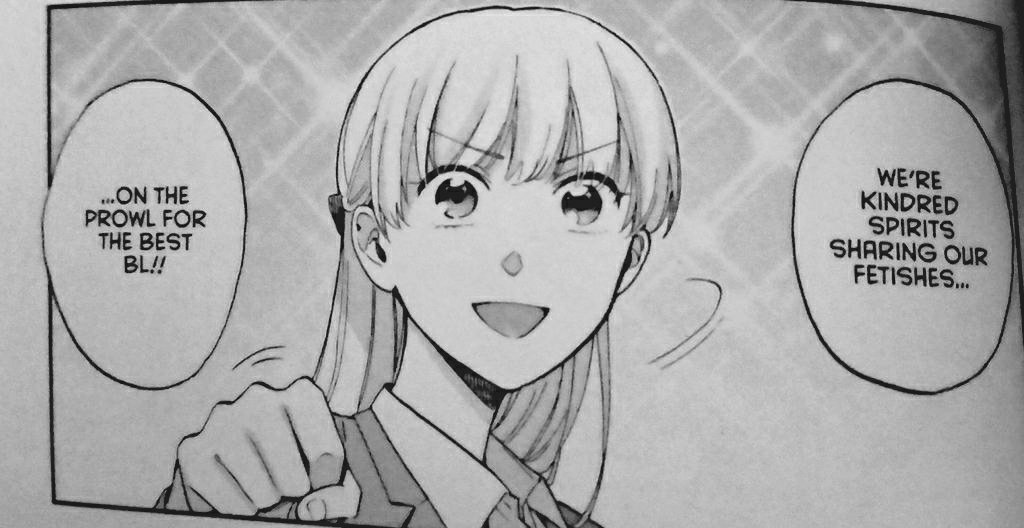
The comedy is heavy in the manga, which makes the touching romantic moments stand out all the more. And the mangaka, Fujita, isn’t overly precious about those moments. Narumi is pretty clueless about both her own feelings and those of Hirotaka, but in a way that feels genuine as opposed to frustratingly ditzy. She and Hirotaka have been friends forever, so their relationship is already rock-solid, their trust already established. She relies on him to keep her grounded, and enjoys his company regardless of their new dating status. I’ve always been a firm believer in friendship being the cornerstone of any romantic relationship, so I love the way theirs develops.
I don’t want to give too much away, but from the first two volumes alone, it appears that I’ll be getting my fill of wacky antics, nerdy in-jokes, heart-rending backstories, and genuinely moving romantic gestures. I’m grateful for a series that recognizes the growth in my tastes, but also the state of my concerns as an adult woman. With the anime streaming right now, I hope that the manga becomes the success it deserves to become and thus ushers in a new wave of licenses for the modern otaku lady and her modern lady concerns!
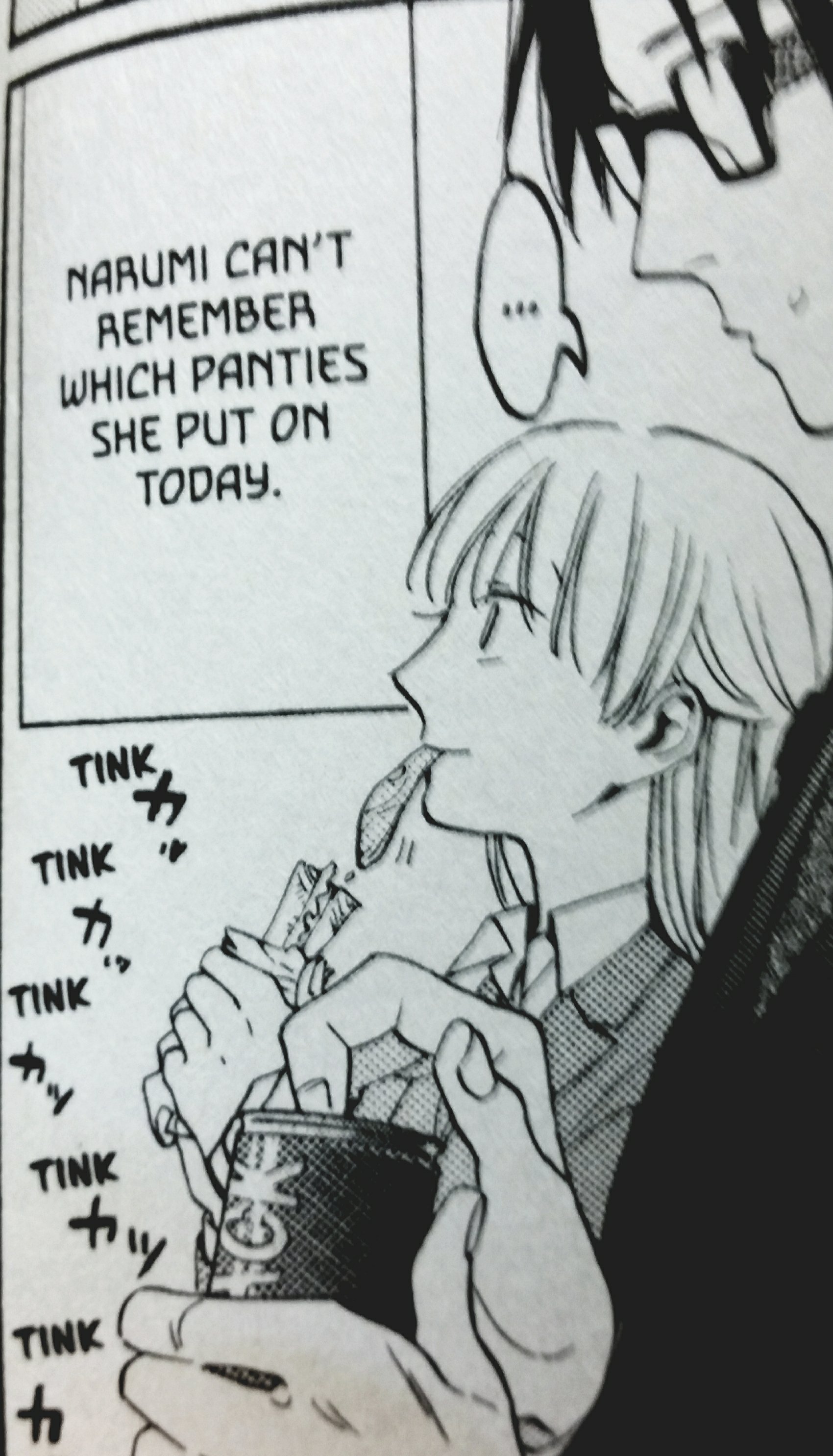
Pride and the Manga Market
Happy Pride! I spent yesterday dolled up as Loki, marching with various other Avengers as a part of Boston’s Pride Parade. It’s something we’ve been doing at Comicopia for the last decade now, though this is only my second time going, personally.
Marching in Pride is pretty tiring, but being there reminds me of why this kind of visibility is important for the queer community — of Boston, and of the world as a whole. I marched and screamed and smiled while hoisting the bisexual pride flag high, and I locked eyes with a small child wrapped in their very own bi pride flag. Another little one ran right out and gave me a hug, and countless people cheered as they saw me: visible and queer and there to celebrate myself and them.
But queerness isn’t visible everywhere, or at all times. It’s not allowed to be part of so much of mainstream culture, even now in 2018. In the comics world, however, it’s steadily on the rise. I have kind of accidentally read a lot of gay material this year; and while the content and quality vary greatly, that’s not something I could have said a scant five years ago.
I feel as though I can hardly scroll through my Twitter feed without someone bringing up My Lesbian Experience With Loneliness, and I’m glad of it! It’s sequel recently came out, the first part of My Solo Exchange Diary. And Seven Seas has also released The Bride Was A Boy, which I have already covered; soon, they will also have released Riyoko Ikeda’s Claudine, about a transman living in 19th century France.
The yuri market seems to be expanding as well, and though Seven Seas has often taken the lead in that genre, we’re seeing Viz Media throwing their hat in the ring with titles like After Hours and Sweet Blue Flowers. And they’re going to be publishing some BL too (or perhaps the term shonen ai would be more appropriate in this context), under their normal Viz moniker, not their SuBLime imprint: That Blue Sky Feeling, coming out in August.
Volume one of Gengoroh Tagame’s My Brother’s Husband came out last year, and we’re expecting its sequel in the early fall. Fantagraphics recently reprinted the Massive bara anthology, which is excellent for us because…honestly, we sell a ton of Tagame and bara in general! I know that’s probably not typical, I can’t completely fathom why we’re able to move it the way that we do.
I haven’t even gotten to talking about non-manga comics, with publishers like Boom Studios and Oni Press taking the lead in queer material, especially queer material for young audiences. And a lot of those gay young people books? It’s clear that they’ve been influenced by anime and manga.
So. What does this all mean? I would surmise that someone somewhere has realized that queer content is marketable. For a long time, that market seemed to be fujoshi scrambling for yaoi, but the tides are turning a little bit. A lot of those fujoshi have explored their own sexuality or identity and found themselves identifying as something other than straight or cisgender. They’ve been joined by fudanshi, perhaps. Or maybe the strange nature of animanga has made readers flexible to ideas outside of their norm.
I can’t say, of course, that that’s how things have progressed. But I can say that for me, the animanga community has always been very…well, gay. I had a conversation with someone about the local Massachusetts Independent Comics Expo (MICE) recently, and when I said I loved it because it felt like one big artist’s alley, he responded that it seemed much queerer than any artist’s alley at any con he had ever been to. And that’s when it hit me — the comic book conventions cater to a completely different crowd than the anime conventions. I mean, obviously, right? But not just in content; in age and economic standing and social status…in every way imaginable.
We’ve graduated from the yaoi paddles of my adolescence, thank God, but I can’t spit at Anime Boston without hitting a kid wearing a YAOI-emblazoned snapback. I sell out of My Lesbian Experience With Loneliness and I Hear the Sunspot on a regular basis at the store, and still sell them with lightning speed at shows. I see pronoun pins on shoppers almost as often as I see character goods.
And some enterprising person (or people), perhaps queer themselves, has discovered that there is a whole group of people out there whose media is under-serving them on a daily basis. And so they’re filling that niche. That sounds cynical, and clinical, I guess, but it’s really a wonderful thing.
The first Pride march was a riot; the current Pride parades have corporate sponsorship. The nature of achieving progress in our society, as it currently stands, seems to necessitate becoming a “commercial success,” so to speak. I don’t love the coupling of business and marketing with identity; I hate the fact that my Pride marshal badge both this year and last proudly proclaimed the name of a bank sponsor. I don’t trust corporations to do better just because they choose to align themselves with a hot topic like feminism or gay rights or whatever.
But…I feel differently about the world of publishing. It’s naiive, perhaps, and maybe it’s because I know people who work in publishing that I’m able to hold on to this hope. Comics as an industry is a mess, but I want to see myself and my queer siblings as the heroes of our own stories. I want to trust that these license agreements are coming not solely from a sales point of view, but from a desire to help bolster visibility.
And while the queer stories themselves are a boon, I want to see a growing trend of stories by queer creators. I think that’s the most important way to show support — to give a voice to those who for so long have been voiceless. To allow those creators to feel safe, and listened to, and proud.
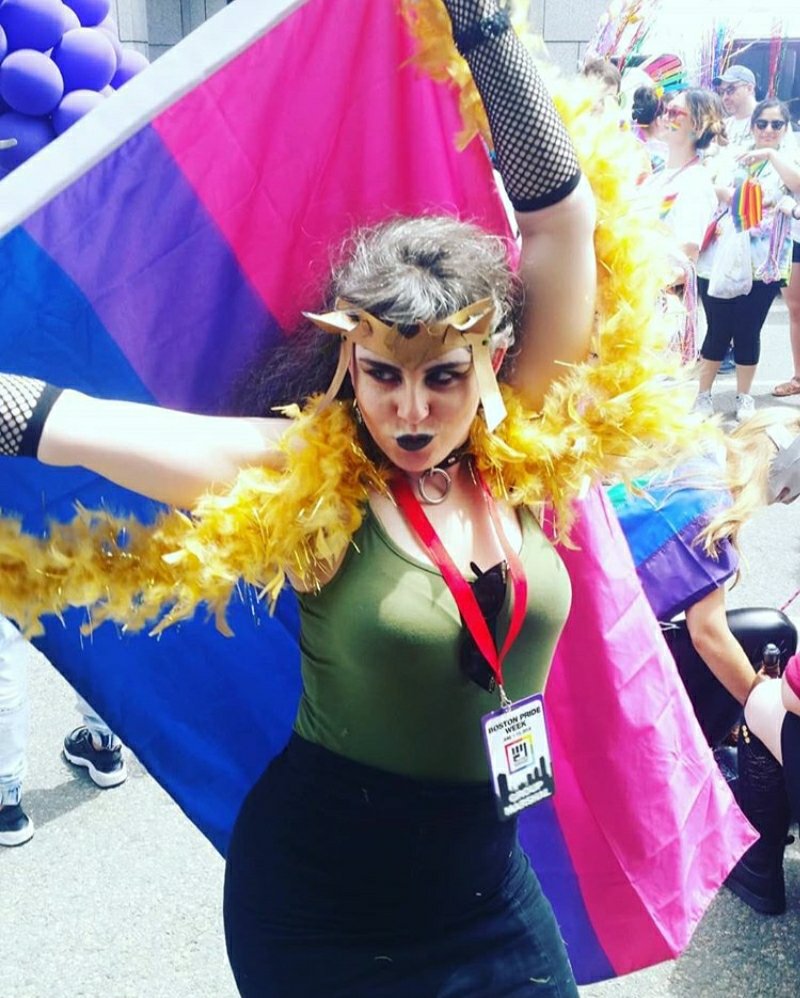
25 Otaku Facts About Me — From The Manga Hoarder!
One of the bloggers I follow, known as The Manga Hoarder, did a cute little list of 25 otaku facts about herself, which you can find here. Since she invited others to take a crack at it, I thought I’d give it a go. This blog is still fairly new, so I hope this helps to give readers some insight as to who is behind the keyboard.
Without further ado, the list:
1. I’m sure I’m not alone in this, but both my first anime series and my first manga were Sailor Moon.
2. I’m pretty flexible about what genres I read, but my favorites are shonen action from the 90s, horror, BL that isn’t burdened by harmful tropes, and women writing about women’s problems.
3. I…really don’t care at all about Evangelion. I’m sorry. I can recognize its importance, but it does pretty much nothing for me.
4. Yu Yu Hakusho is my favorite series — both anime and manga. You might have been able to tell from my blog’s banner image!
5. It’s only in recent years that I’ve been interested in reading vintage manga, stuff like Hino Horror, etc. I think I was biased as a younger reading toward manga with pretty boys and protagonists that were my age. Now…I want all the weird old stuff.
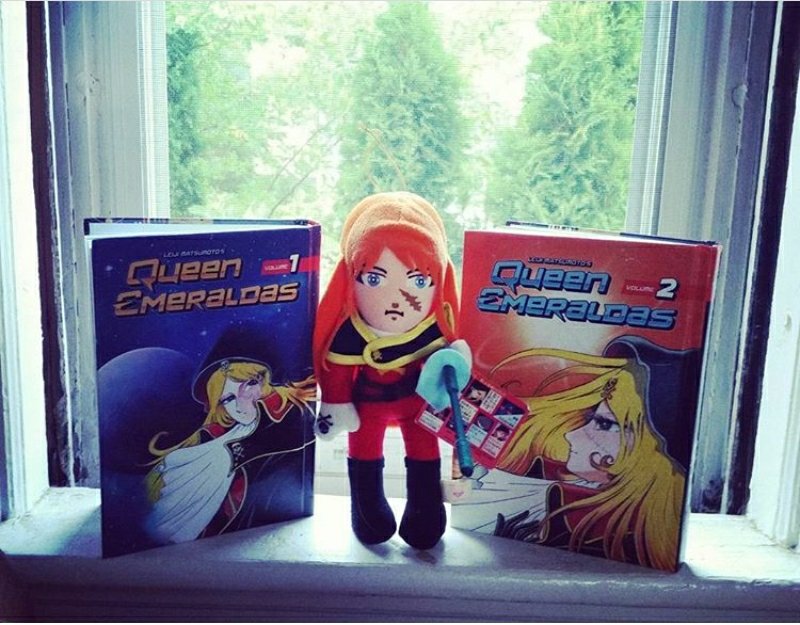
6. I first watched Akira at the tender age of 9, when my best friend brought over her older brother’s VHS copy. We watched it in my basement and prayed that my grandmother wouldn’t interrupt us and demand to know what we were doing!
7. I attended my first convention — the very first Connecticon! — for a friend’s birthday in middle school. Unbeknownst to me, my current boss was also there, selling things! And now I go every year to my home con to sell manga to the next group of nerdlings — I’ve come full circle!
8. I have had several false starts at learning Japanese, but it remains a goal of mine. I’m not sure I’ll ever be completely fluent, but it would be nice to be able to hold a conversation and read some simple things.
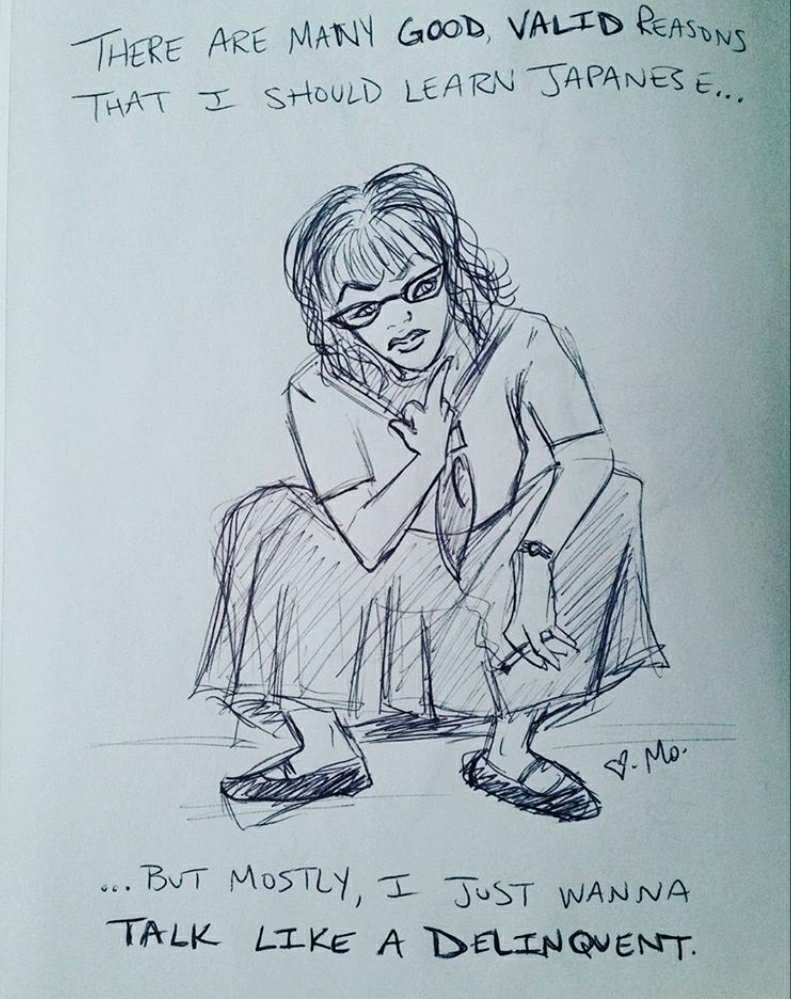
9. The yaoi/BL/slash community and the media surrounding/that’s part of it can definitely be…tumultuous? But I’m glad it was available to me at a critical point in my life, because I think it allowed me to think flexibly about sexuality — both my own and other people’s. That’s why, while I’d still like to see better, less harmful BL books coming out, I can’t every really dunk on the genre completely.
10. I like manga better than anime, and consume it far more readily and rapidly.
11. In the last few years I’ve been in the privileged position of being able to increase my manga collection. I know it’s a drop in the bucket compared to some, but I’m hovering somewhere around 500 manga in my collection so far!
12. I desperately want the From Eroica With Love license to get rescused, and for the series to be completed in English!
13. I successfully turned someon into a manga reader by recommending A Silent Voice. She went from knowing nothing about the medium to starting her own collection and attending cons within a few months. When she told me, I was inordinately proud of myself. 😛
14. I didn’t really read any manga during college (which I hear is a common occurrence). When I got back into it, I suddenly felt like I had been missing a part of myself all along. (I felt similarly when I got back to novels after a long time away — I am one of Nature’s bookworms.)
15. I am constantly perplexed by otaku who are really into anime but have no interest in other aspects of Japanese culture. Media isn’t created in a vaccuum, so I always felt the need to delve a little deeper into the backgrounds of the stuff I was consuming.
16. I can’t hear cicadas buzzing without thinking of anime.
17. I really like reading about the manga industry, both in Japan and elsewhere. I have a huge stack of non-fiction books on the subject that I need to read!
18. I have a huge weakenss for artbooks and own a good handful, both Japanese ones and English-language ones. I have exactly zero resistance to any Yoshitaka Amano book.
19. I am also, conceptually at least, fond of boxsets, though I have fewer of those. I did splurge on the Akira manga boxset and have no regrets about that — it’s beautiful.
20. I don’t have very many anime figures, and I know what a deep hole that cam become…but I really want some more.
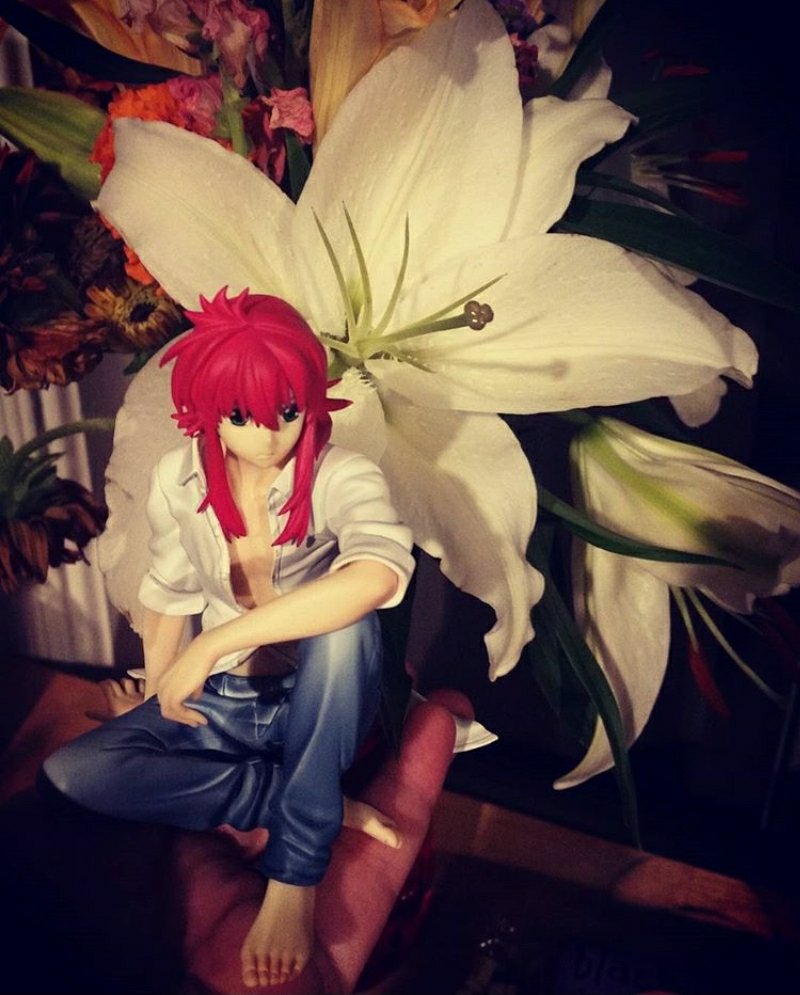
21. I love Vampire Hunter D, but I haven’t read any of the novels yet! I have the first one, I’ve just gotta start.
22. For Christmas a few years ago, my husband got me the Kitaro one-cup sake set. I love the concept of making collector’s items out of otherwise mundane products. Since I’ve drunk the sake (I honestly have no taste for sake), I’ve been thinking of sealing the labels so I can use the cups as little vases or juice glasses.

23. I really love Yu-Gi-Oh!, but I’m a pretty mediocre duelist. I enjoy playing, but I’m much more invested in the story, especially the ancient Egyptian plotline. I wanted to be an archaeologist for a very long time growing up, so this series was like catnip for me.
24. I don’t own a lot of physical anime. I think this is partially because when I was growing up, it was pretty expensive to collect. It’s also very easy to stream things now, so the urgency to own isn’t as great. Plus, I live in a tiny one-bedroom apartment and the books are taking over all the space already! A good handful of the things I do own are on VHS, and I’ll likely never be able to update them as their license has lapsed or the company has since gone out of business.
25. I’m not always super receptive to people giving me recommendations (on anything, not just animanga) if they don’t consider who I am and what I like. But my job is essentially to give folks manga recommendations, and I enjoy doing it! Learning what other series people like and trying to connect the dots to their next favorite series is like a fun puzzle for me…so basically, don’t be afraid to ask me for recs!
And that about wraps it up! It took me a couple days to come up with all these facts. Despite the fact that I’m a pretty open person, it can sometimes be hard for me to write about myself in this way. This was an interesting challenge!
I encourage you all, once again, to go check out The Manga Hoarder; she’s often got really great reviews up, and she’s currently running a readathon and some giveaways!
Comic Book Trivia and Gunpla Fun
I honestly don’t have much to report this week, but since I’ve been keeping up with this blog regularly, I feel loath to break the habit for even just one week, lest I fall behind. The past week at work as been super busy, such that I haven’t felt up to doing too much reading with intent to review, or anything like that.
This weekend has been fun, though! After work on Saturday night, my coworkers and I legged it over to another comic shop for their annual Battle of the Comic Shop All Stars, in which several local comic shops put together teams of four for a comic book-based trivia event to benefit charity. Our team is usually second to last (that’s what we got this year, too), but it’s still super fun and I learn a lot of random facts about first appearances and whatnot. And just for me, this year they had a “name that anime” sheet full of screenshots from various series. I aced it. 😛
When I got home from that, I found that I had received a package from my oldest and best friend. She had had some trouble sending it to me in time for my birthday, but it finally got to me and it was a pair of completely adorable handmade Sailor Jupiter transformation wand earrings!

And then there was today…I drove (by myself for the first time ever!) to the local East Asian supermarket to get a load of snacks for a Gunpla building party that another friend was hosting. The only Gundam series I’ve ever been able to become invested in is Gundam Wing, so naturally I built myself another Sandrock model — this time a Master Grade, which was an interesting exercise in fiddly bits and frustration.

As we were building our models, we listened to some Gundam tracks, and then watched some various Gundam series — including Gundam Wing Endless Waltz. Remember the friend who made me the earrings? Her name is Sara — well, Sara and I used to watch Endless Waltz every single day after school for the better part of a year. It’s deeply important to me, and tied to my reasons for getting into fanfiction, drawing, and animanga as a whole.
I am the type of person who is extremely prone to nostalgia, so I didn’t need all this external help to start reflecting on my past and my passions. In truth, I do it often; I do, professionally, what I did for fun as a teenager basically. I always say that 13-year-old Morgana would think 28-year-old Morgana is so cool, and on some days…that’s really the sentiment that keeps me going.
Working in comics has allowed me to relapse, but not in a bad way. I’ve been able to come back around to things I really care about, and not only am I engaging again in singular, personal hobbies that used to be important to me, I’m also engaging in a community of people with similar hobbies and interests.
The more and more I delve into comics, the more I feel the particular pull of community, and how important I believe it is to have a community that is supportive and uplifting. Conventions like Anime Boston and ConnectiCon, both shows which I do with work, have that feeling of community that I think some of the bigger shows are starting to lack for me. Of course, CTcon is my hometown show, so it’s always going to feel like home. I walk through the Hartford Convention Center and remember that time I was randomly asked to dance by a Vash cosplayer, or that time a bunch of people piled into the lobby to watch AMV Hell.
There are times when I am envious of today’s teenagers; every series they could possibly ask for is at their fingertips, streaming or available to read digitally through so many publishers. At the risk of sounding like an ornery old person, they have no idea how good they have it. I hear complaints about manga chapters not getting translated quickly enough, and I am bowled over by the fact that only fifteen short years ago, literally NOTHING came over to North America with any kind of speed or even decent translation sometimes.
So sometimes I’m envious that kids can buy their anime swag at their local Hot Topic (though I also can partake of that, of course). But there’s also that deeply sentimental side of me that wouldn’t trade the weirdness of growing up in the 90s and 2000s for the world. There is something very beautiful to me about having to wait for a certain time after school to get the next episode of your favorite series, or hunting through the VHS tapes at your local video rental store for something you haven’t already seen (preteen Morgana saw some series at perhaps too impressionable an age).
I don’t particularly truck with the idea that my youth — or anyone else’s — was any better than the youth of kids today. I think a lot of dangerous ideas can come out of dwelling too much in certain kinds of nostalgia. But I’m also grateful for what I had, and I hope that the next generation of nerds finds a similar solace in their own nostalgia without having to tear down the generation that follows. For those of us who love stories, I think memories and the emotions that surround them are important. I don’t think that’s something that changes much, no matter when you were born.
The Bride Was A Boy, and Empathy Through Comics
I want to start off this post by acknowledging that this week has been a deeply ambivalent one in the comics world. The two-thirds of my Twitter feed that aren’t dedicated to anime memes and cute animals were split with coverage of recent Comicsg*te abuses and coverage of the Toronto Comic Arts Festival — namely, the worst and the best that the comics world has to offer, respectively.
I don’t want to dedicate too much time to discussion of the former issue for various reasons, but not least of all because in light of efforts to push certain people out of comics, I find my desire to uplift the voices of those people becomes stronger. And so, I’m going to have a go at my first official review here, of The Bride Was A Boy, by a woman who goes simply by the name of “Chii.”
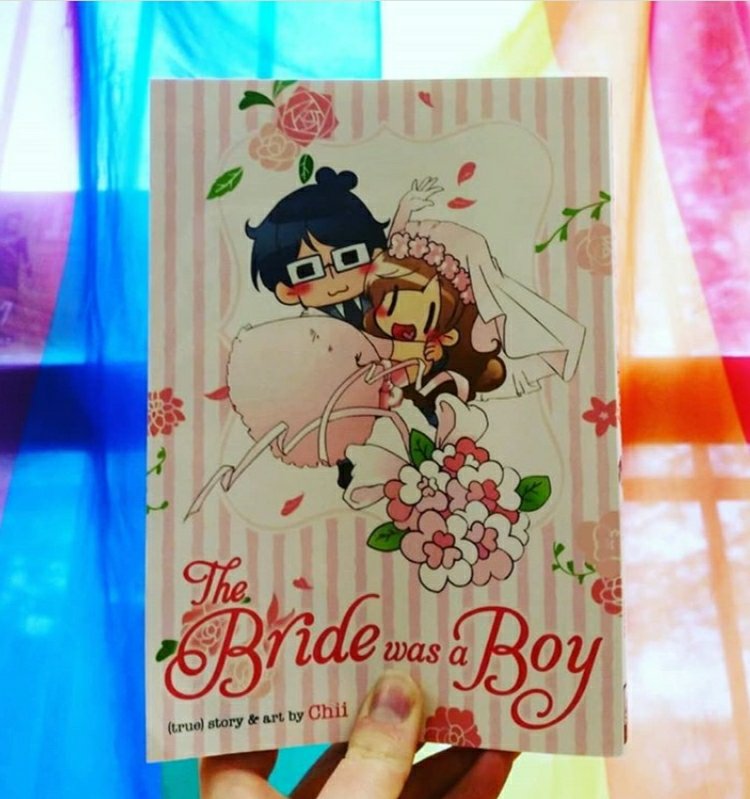
When Seven Seas Entertainment published My Lesbian Experience With Loneliness, they struck gold; I’ve discussed before in various venues the great pull of that book, among manga readers and non-manga readers alike. There was a great need for this — an autobiographical manga about queerness and depression that allowed readers to either relate, or to empathize and find common ground. It was very smart, then, for Seven Seas to pick up The Bride Was A Boy, because I feel that autobiographical trans narratives are even more necessary in many ways.
Though the manga is billed as being about preparation for Chii’s wedding, in reality it is the discussion of Chii’s journey through womanhood, from her discovery of being trans to her decision to go through with sex reassignment surgery and becoming legally “female.” Throughout this journey, she has a great deal of support from her family and her soon-to-be-husband (whom she alternately refers to as “Boyfriend-kun” and “Husband-kun”). Between chapters, Chii takes the time to break down some terms and laws that people outside of the LGBT+ community might not be familiar with. They are simple explanations, but they are a good basic primer for anyone who is just starting their journey into trans issues.
I honestly wasn’t sure if I’d like this manga — not because of the subject matter, but because of its presentation. It’s laid out in 4-koma style, which doesn’t typically appeal to me, and the artwork is simple, adorable chibi-style characters. It hardly seems like it has the same underground, confessional feeling of MLEWL. Though I was excited that a trans story was being published, I worried that it was Seven Seas scrambling to ride the high of MLEWL‘s success without regard for the subject matter itself. I found, however, that I truly loved it.
There has allegedly been some criticism that The Bride Was A Boy is too positive; again, Chii is very lucky to have a very supportive and loving family and partner, which may seem like a distant reality to many trans folks. But I think that a positive, autobiographical trans narrative is very important. It is not the job of trans people to constantly struggle for the benefit (and entertainment) of others. Presenting trans womanhood in this way offers it very simply as just another kind of lived reality. It is my fondest wish that cisgender people will pick up this book and maybe come to learn new things about trans people, or come to understand the feelings of trans people better. And I also hope that readers then continue to demand more trans stories, both fictional and non-fictional, that are earnest, entertaining, and which ultimately help to cultivate a culture of empathy. (For this reason, I’m particularly fond of the intermittent breakdowns of terminology and law, and want to acknowledge Beni Axia Conrad for the extra work they must have done to translate these pieces to reflect both Japanese society and relate them to what English-speaking readers might expect in their own societies.)
I’m idealistic, I know. The comics community has more excellent content from queer creators, creators of color, and women creators than ever before, yet we’re seeing an incredible amount of backlash from the unhappy few who continue to do harm, verbally or otherwise, to those already marginalized. I spent much of this week feeling helpless in light of that reality. But reading The Bride Was A Boy reminded me that it has always been my philosophy to use my relative privilege, and my position as someone who reads and recommends comics professionally, to keep people engaged with good work from deserving creators. There will always be people who stand obstinately in the path of progress and understanding, who want their position on the top of the heap to remain unchallenged. But the fact remains that, for many, comics have always been about challenging the status quo, about saying things that the privileged don’t want to hear. It is my hope that comics continue to shake things up and push that status quo even further into oblivion.
With all that said, I happily recommend The Bride Was A Boy to people of all genders as a warm, joyous, informative story about one woman’s journey to manifesting her best life. I would like to see it getting just as much lip service as My Lesbian Experience With Loneliness. May these manga pave the way for the translation of more excellent queer stories!
Free Comic Book Day, and the Plight of the Local Comic Shop
Last week was extremely busy for me. On Tuesday after work, I went to Nick Cave’s Q&A show; on Wednesday I scrambled to go see Avengers: Infinity War after work because I didn’t want someone to spoil me on FCBD; and Thursday and Friday were, of course, all prep for said FCBD.

There has been a lot of discussion about how Free Comic Book Day is not free for comic shops. This is true, we buy tons of comics for slightly less than our usual cost with the sole purpose of giving them away with our sticker or stamp on them in the hopes that people might pick up something they really like, remember where they got it, and come back to get more. It’s part goodwill gesture, part advertising — and it can be an awful lot of work.
I’m not here to suggest alternative solutions to the current FCBD model, though I welcome such discussions. What I want to talk about is a conversation I had with a gentleman who just knew, somehow, that comics readership was up because of the Marvel Cinematic Universe. After we went back and forth for a while, he apologized and recognized that his information was anecdotal, and honestly I don’t want to spend too much time talking about him in particular because he was actually very nice and clearly did care about comics.
But prior to our conversation, there were two things that he believed: that the MCU got people into comics, and that perhaps a lot of those people were getting their comics from libraries instead of buying them in shops.
I can tell you all, without hyperbole, that just about every single comic shop, even if they’re doing fairly well at the moment, feels the grip of Amazon closing in on the throat of their business. Every retailer I’ve talked to is finding ways to add alternative merchandise to their stores, or lean really hard into a niche they already have (I’m always going for “gay manga store,” myself). The only comic book films that have sparked any small interest in comics, that we’ve seen at my shop, have been Wonder Woman and Black Panther, and I think that speaks a lot more to people finally seeing themselves reflected in media and being hungry for more of that, than to any specific interest in superheroes or comics specifically.
I can also tell you that last I checked (which admittedly may have been some time ago), the best-selling Marvel trade paperback collections were Ms. Marvel, The Unbeatable Squirrel Girl, and Ta-Nehisi Coates’s run on Black Panther. That’s two YA titles starring characters that haven’t yet been in a Marvel movie, and a comic run written by a well-known author who made his name outside of comics. These aren’t necessarily the Marvel trades that do best in our shop, but I’m willing to bet good money that they’re the ones that are getting checked out of your local library most often. (And I would absolutely LOVE some insider info from a librarian on how their graphic novels perform.)
So every year, FCBD gets to feeling more and more desperate as retailers all over the country (and indeed in other parts of the world) continue to throw money, effort, and time into giving away literal tons of free comics in the hope that they’ll gain a larger portion of the community — whether that community already reads comics elsewhere, or whether they’re completely new to the medium. I could say, too, that we’re not being helped by certain publishers who seem to be substituting quantity of titles for quality of writing, but I’m not sure that would be completely fair as I’m not a “superhero person,” and I haven’t been keeping up with a lot of current material.
I hate feeling selfish and petulant when I remind people to shop locally (and ideally, I’d love for us all to be able do all shopping locally, not just comics). I understand what it’s like to not have the means and the funds (I work retail, remember?). But as I was telling my husband last night, unless something dramatic changes in society or we finally get the Y2K we were promised twenty years ago, I don’t see brick and mortar shops — of any kind — surviving. The “frivilous” shops will go first: the comic shops, the toy stores, any niche specialty store. I honestly can’t say whether that’s good or bad on a grand scale, but it certainly does make me sad and worried for my own livelihood and the livelihood of so many wonderful, smart, dedicated people I know who put so much of themselves into their businesses because they were once a young person who just really loved comic books.
And completely appropos of nothing, I’m getting really tired of people saying “it’s backwards” every time I hand them a free manga sampler. But I reckon I could construct another whole post just about how reticent people are to try new things…though I will say, a remarkable number of people I offered free comics to yesterday said “oh, I don’t read comics.” So maybe that’s part of the problem, too, that people can’t see themselves reading comics, or don’t know all that comics have to offer, in these days where superhero action flicks are breaking records at box offices around the world.
“Yeah, I saw the Avengers, it was great! But….no, I don’t read comics.”
Eisner Blues
A few days ago, the Eisner nominees were announced. Manga has its own category (kind of), which is “Best U.S. Edition of International Material — Asia.” Of course, in the past we’ve seen that this isn’t limited strictly to manga, but typically that’s where it all gets put. To be honest, I kind of hate that there’s a separate section for manga, in much the same way/for the same reasons I hate there’s a “Best Foreign Film” category at the Oscars; instead of being pitted against series in its own genre or of its own type, a manga gets pitted against other manga it may or may not have anything in common with. (Though to be fair, all of the categories in the Eisners are multi-genre.)
This year, as with most years, I would say the nominees are certainly of a type, and that type is “appealing to people who can’t figure out manga.” The books themselves are all very deserving, I won’t argue that point. But they are all, with the exception maybe of Golden Kamuy, pretty high-brow or else packaged as prestige books, many from publishers that don’t deal exclusively with manga.
The nominees are, by the way: Furari, by Jiro Taniguchi, translated by Kumar Sivasubramanian; Golden Kamuy by Satoru Noda, translated by Eiji Yasuda; My Brother’s Husband volume 1, by Gengoroh Tagame, translated by Anne Ishii; Otherworld Barbara volume 2, by Moto Hagio, translated by Rachel Thorn; and Shiver: Junji Ito Selected Stories, by Junji Ito, translated by Jocelyne Allen. Kodansha’s Akira box set was also nominated a couple times, under “Best Archival Collection/Project — Comic Books” and “Best Publication Design;” and H.P. Lovecraft’s The Hound and Other Stories, adapted by Gou Tanabe and translated by Zack Davisson, was nominated for “Best Adaptation from Another Medium.” (I own the Akira boxset, by the way. It’s gorgeous, and it absolutely, 100% deserves an award.)
As I said, I have no words against any of the manga nominated. Shiver is actually one of my favorite books to come out in the last year, though I might question whether it’s the Ito book that is most deserving of an Eisner. No, my quarrel is that the Eisner committee continually ignores what the manga-reading community cares most about, and it tries to frame the more “worthy” manga as being literary, or by a creator who is so far removed from what the majority of readers are enjoying. Jiro Taniguchi is great, but he’s dead now, and his work is almost impossible for me to sell to the kids coming in for the latest volume of My Hero Academia. There is an implication here that manga is only worthwhile if it meets certain criteria; it’s much the same attitude that people who insist on a difference between “comics” and “graphic novels” have. It’s pretension.
Beyond that, there are never enough women nominated. And once again, Moto Hagio is great, but I’ve had the same volumes of Otherworld Barbara sitting on the shelf since they came out. I just had to put aside the store’s copy of The Heart of Thomas for myself, since we haven’t been able to sell it for over a year. No one is reading her material. That’s scandalous in and of itself, but it’s the truth. What I really, really don’t understand is how on earth Nagata Kabi’s My Lesbian Experience With Loneliness (also translated by Jocelyne Allen) managed to not get nominated. Maybe it’s just in the social media circles I’m part of, but it got talked about a TON, and has had multiple printings. And it’s one manga that I’ve been able to sell to non-manga readers, often without prompting! To say nothing, of course, of the subject matter, which is deeply moving and needed now more than ever.
It’s not just the nominations committee that’s responsible for who wins, of course. Comics creators, journalists, shop owners and managers — all these people get to vote (yes, including me). I know lots and lots of wonderful retailers and comics journalists! I also know that the majority of them know very, very little about manga. This is not solely their fault, and part of my goals within the retail sphere has been to really push manga into other shops, to give retailers the tools to navigate a medium they didn’t grow up with and therefore have no frame of reference for. But that lack of knowledge has meant that many deserving series or titles don’t get recognition.
I know that awards shows/ceremonies are all the same, that it’s a huge popularity contest that doesn’t immediately devalue works that aren’t nominated or that don’t win. But it’s frustrating to see so much quality work go unnoticed because manga is still perceived as too foreign, or as immature, or as…whatever it is that people who refuse to read manga feel that it is. I wish there wasn’t a separate category for manga — but if there wasn’t, I wonder if any manga would get nominated?
One good thing that has come out of the Eisner nominee announcements is that I discovered an utterly beautiful web/digital comic called The Carpet Merchant of Konstaniniyya, by Reimena Yee, which can be found here. I highly, highly recommend it, especially if you like historical romances, vampires, gorgeous patterns and colors, and a story that is likely to make you cry. I’m still so very, very impressed with it, and I can’t believe it had slipped past my radar until now!
If it were up to me, by the way, I would nominate the following, based both on my personal judgments and on what I see selling well in my particular store:
- My Lesbian Experience With Loneliness, by Nagata Kabi (Seven Seas Entertainment)
- My Hero Academia, by Kohei Horikoshi (VIZ Media)
- I Hear the Sunspot, by Yuki Fumino (One Peace Books)
- Descending Stories: Showa Genroku Rakugo Shinju, by Haruko Kumota (Kodansha USA)
- The Girl From the Other Side, by Nagabe (Seven Seas Entertainment)
Bags of BL
Last week, I went to go pick up some manga that a friend was getting rid of — several bags of yaoi, all out of print at this point. There were a lot of treasures in and among them that I hadn’t read yet, plus she tossed in a few extra manga that she had found laying around (including a hardcover copy of Shirahime-Syo, by CLAMP).
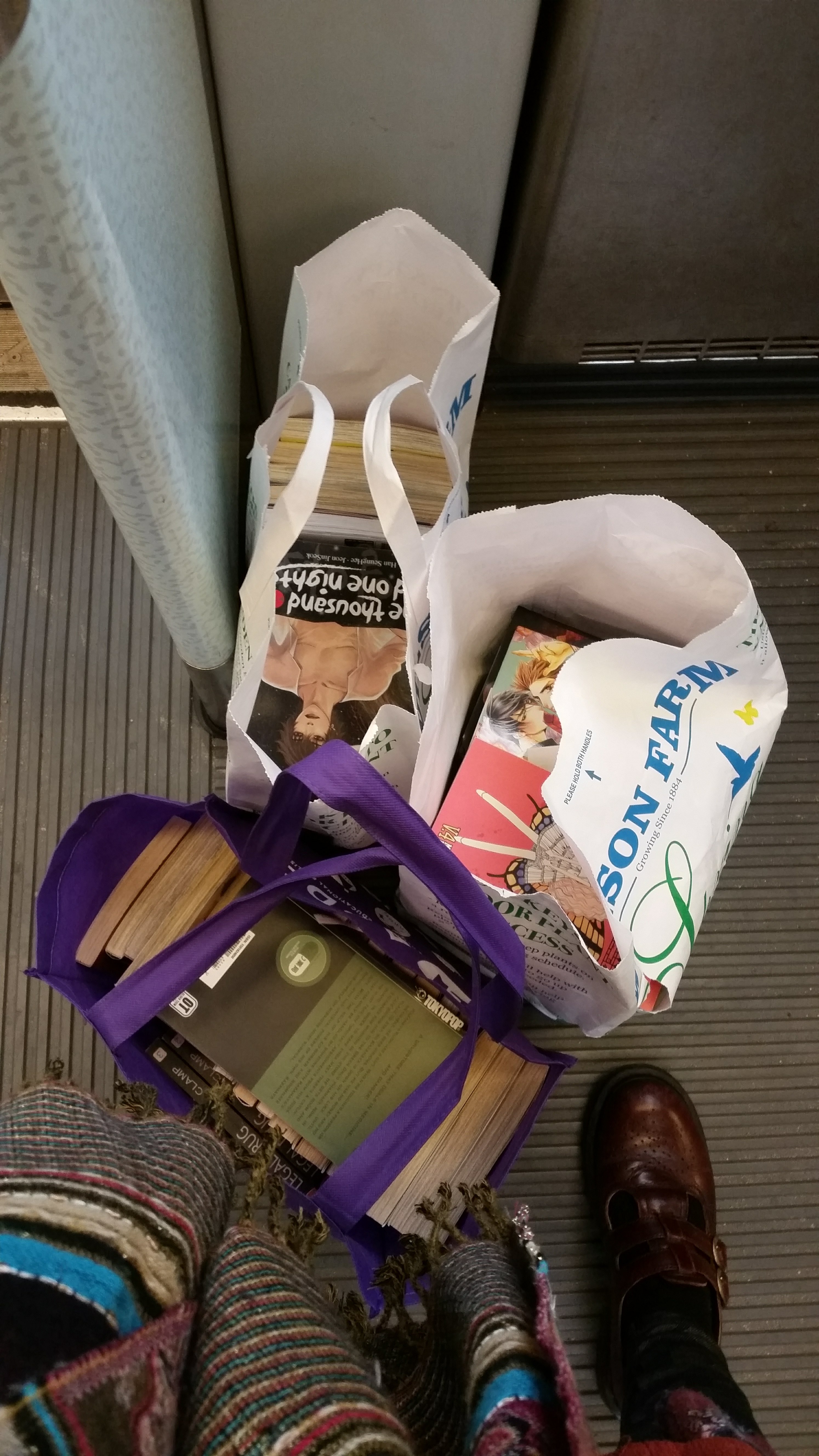
I’ve only had a chance to read two of the manga so far, Same-Cell Organism, by Sumomo Yumeka, and Say Please, by Kano Miyamoto. I enjoyed the former quite a bit; it was a collection of sweet, fluffy BL stories that I would feel comfortable recommending to just about anyone. The latter…well, I’m super exhausted by the domestic abuse tropes in yaoi, and if Say Please had left those out, it might have been perfectly fine. As it was, it was hard to believe in the “five years later” happy romance when I couldn’t stop thinking about the assault that occurred earlier in the story.
I’ve been trying to keep up with yaoi as it’s coming out these days, and I have to say…there are still a lot of problems, still a lot of harmful tropes. But on the whole, it seems as though there’s a bit more vetting going on of material that could be considered offensive or harmful. It’s been nice to see titles like Yuki Fumino’s I Hear the Sunspot get their English debut; stories that aren’t centered around sex, but around creating bonds and falling in love are more gratifying for me than straight-up porn. Even some of the saucier titles have been a real treat, though! I really enjoyed Scarlet Beriko’s Jackass, which could have so easily fallen prey to any number of horrible tropes. I’ll admit, as I was reading it, I was trying to predict how long it would take before I became thoroughly disappointed in my choice of reading material. Glad to say that disappointment never came!
I know that rummaging through the backlog of out of print DMP yaoi is going to be…challenging. I suspect there was a sort of “we’ll take what we can get” mentality about licensing at the time, and fans were so hungry for whatever they could get their hands on that they were willing to overlook some of the more egregious faults of the BL genre. But North American fujoshi are pickier now, I think. I know I certainly am! But I also think there’s a certain value in me going back and reading through this material I wasn’t able to get my hands on at the time of its publication (either because the places I shopped didn’t carry it, or because I was too young at the time to legally buy it).

I’ve heard Vassalord is…a wacky time.
Even though manga and anime are more popular and accessible now than ever before, there will always be certain series or whole genres that remain under the radar of public consciousness. I think BL is one of those genres; it’s so niche, and can be difficult to navigate. Something like yuri, I think, will continue to grow in popularity because not only will lesbian readers snap it up, but ostensibly straight men will, too, and they will pass it along to their friends and talk it up on social media. (As an aside, I remain pleasantly surprised every time I sell My Lesbian Experience With Loneliness to a man. I always wonder if they know what it is ahead of time, or if they think they’re getting a fun sexybook.) BL will never get that treatment because its main reader base is women, and in my experience women’s opinions on what is sexy are treated as less important. I don’t mean to imply that gay men should feel the need to read BL; Lord knows it’s not generally a great example of actual, genuine homosexual relationships. But BL gets put through the ringer a lot in ways that other media doesn’t, and I can’t help but think that it’s mostly because it’s something that chiefly women read and talk about and bond over.
It is my hope that in the coming years, we’ll see a lot more BL translated into English that appeals to a variety of readers. I get men in the store frequently who want BL but don’t like the painful stereotypes, or who aren’t really interested in porn as much as in gay romance. I’d like to be able to give them more recommendations than just I Hear the Sunspot and His Favorite. And I’d like to see the Western comics world tackle gay male stories, too! There have been a couple good ones lately — Taproot and Generations, both published by Lion Forge, come to mind. Let’s keep the trend rolling!
In the meantime, I’m going to try to wade through all these old books that I had to carry back to the store via the train. Anyone have any remedies for an achy shoulder..?

The resemblance is uncanny!